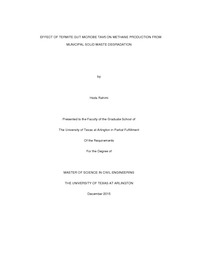| dc.description.abstract | Methane from anaerobic processes is being increasingly utilized as an alternative energy source in developed countries, via large projects that extract methane from landfills or wastewater treatment plants. Anaerobic degradation of organic material (biomass) involves decomposition by bacteria under humid conditions without any oxygen. Organic carbon deposited in landfills is converted by microbes to carbon dioxide (CO2) and methane (CH4). If the methane is not captured, it contributes to climate change (25 times more effectively than CO2 on a per-mass basis). If the methane is captured, it can be used as a renewable energy resource. Lignocellulose comprises a significant portion of MSW - 40-70% in developed countries, including paper, wood, yard waste, and textiles such as cotton fibers. Cellulose, the main biodegradable plant polymer, is often shielded by lignin, as well as hemicellulose. Lignin is unfortunately resistant to microbial degradation under anaerobic conditions that normally occur in MSW landfills. Lignin destruction can make cellulose and hemicelluloses available for anaerobic microbial conversion to biogas. This could potentially increase a landfill’s methane production by a factor of 2-3, depending on waste composition. The objective of the current study was to determine the effect of a specific kind of microbe from termite gut, TAV5, in a mixed culture on accelerating MSW decomposition rate and gas generation. To accomplish this, three kinds of waste, including paper and cardboard, yard waste and wood were collected. Six laboratory scale reactors were prepared with selected MSW and operated as bioreactors by recirculating leachate. Three of these reactors were seeded with a mixture of cultures from an anaerobic digester and incubated at 38 °C. The other 3 were seeded with termite gut microbe TAV 5 added to a mixed culture from an anaerobic digester and incubated at 30 °C because the optimum temperature for TAV5 is 30 °C. The pH level was controlled in the recirculated leachate.For both sets of reactors (through day 63 of operation of the second set), the paper reactor had the highest rate of methane generation, because paper has the largest amount of cellulose among yard waste and wood, and higher surface area in comparison with wood, as well as the largest cumulative volume of methane, followed by yard waste, and finally wood waste. The 3 reactors seeded with the TAV5 microbe reached the methanogenesis phase faster than the 3 reactors seeded with ordinary digester sludge. Through the first 63 days of reactor operation, for paper, yard waste, and wood waste, the reactors seeded with both TAV5 and digester microbes had higher rates of methane generation, as well as larger cumulative volumes of methane generated, compared to the reactors seeded with digester microbes only. Initial results thus indicate that TAV5 is increasing methane generation rate and quantity of methane generation. Reactor operation will be continued. | |


